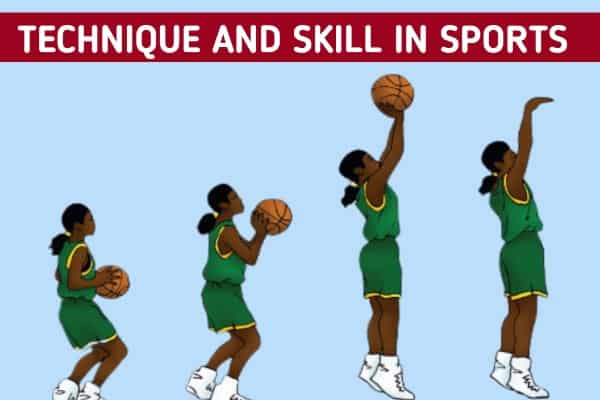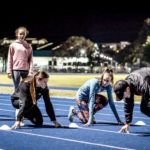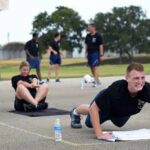MEANING OF TECHNIQUE
The meaning of technique in the SPORTS TRAINING Technique means the way of doing a particular task scientifically.
The technique is defined as the single motor procedure for taking and tackling a MOTION or motor task.
The motor procedure should be understood as a system of movements of a body part in a definite sequence. The technique is always task or goal-oriented. The most common form of presenting the techniques is verbal and physical. The technique doesn’t say anything about the capacity of Sportsman to realize it in the actual movement. It just tells us in what way the movement should be done to effectively tackle a given motor task.
AIMS OF TECHNIQUE
The general aim of technique in different groups of sports are:-
ENDURANCE SPORTS: – IN these Sports, techniques aim at ensuring a high movement economy or reduction in energy expenditure in ENDURANCE Sports, one or two techniques have to be learned. The movements are simple and can be learned in a short period.
For example:- long-distance running, cycling, rowing.
SPRINT: – In the sprint, the technique is to ensure High movement frequency with a High generation of force for a short duration. In these sports also one or two movements are to be learned. For example. 100-meter sprint
POWER SPORTS:– In power sports, that technique aim at generating maximum Force for imparting maximum speed to the body or two and implement in these sports normally one or two techniques have to be learned. The moments are usually Complex requiring a very much longer period of training for perfection. For example. shot put, high jump, weightlifting
TECHNICAL SPORTS:- The Technique aims to execute a movement or combination of an element with high quality combined with Grace and beauty. For example. Gymnastic, driving
REGULATORY SPORTS:- In regulatory sports, the technique aims at regulating a system consisting of sportsmen and equipment or automobile. The force for movements is external and the sportsman has to control and regulate it to get the best result. For example. Sailing, motor-sports, equestrians.
COMBAT SPORTS:- In these sports, the aim of the technique is used to execute learned movement for tackling a task in a consideration of situation and tactics. A large number of the technique are required to be learned and master along with variations.
For example. Boxing, judo, wrestling.


TEAM GAMES:- The technique aims at tackling a task in consideration of situations, opponent’s, teammates, and their variation have to be mastered
For example Volleyball and basketball
CLASSIFICATION OF TECHNIQUE
Meaning of technique in sports training
Read more about- what is sports training
There are three basically classification is determined by the nature of techniques
- SINGLE OR MULTIPLE
- PERFORMANCE OF COMPETITION SITUATION
- CONSTANT OR VARIABLE
SINGLE OR MULTIPLE: – Sports where a single technique determines the performance and which are based on a constant technical model, where the structure of competition is relatively constant this includes more track and field events. Like- Swimming, bowling, shooting, archery.
PERFORMANCE FOR COMPETITION SITUATION:– Sports Where a multiplicity of techniques determine the total performance and where the structure of competition is relatively constant. Within each sport there exist a similarity of Technical model between certain technique, but each technique is identifiable quite separate. This includes artistic gymnastics, dance, figure skating.
CONSTANT AND VARIABLE: – Sports Where a multiplicity of techniques is may be demanded of a rapidly changing competition structure. In this category, come all team sports, combat sports, sports where there are exchange with an opponent such as racket games
The department of technical training must follow Different courses for each classification.
SKILL
Meaning of technique in sports training
DEFINITION:- Skill is the ability to perform a Whole movement skill that can be defined as the capacity of the sportsman to realize the technique in actual action. Skill is defined as automatization of motor action when developing skills; the performer will attempt to improve aspects of their techniques.
For example. If the skill is serving in badminton the techniques are high serve and flick.
CLASSIFICATION OF SKILL
The classification of skill as follows:-
- Open skill
- Close skill
- Simple skill
- Complex skill
- Gross skill
- Fine skill
- Paced or paced skill
- Discrete skills
- Serial skill
- Individual skill
- Continuous skill
- Co-active skill
- Interactive skill
Meaning of technique in Sports training
OPEN SKILL: – Skills that we don’t have control of and that are unpredictable are classified as open skills. The timing of open skill depends on factors external to the performers. In badminton, performing any skill may be affected by many different circumstances.
For example- The position of the opponent on the court.
CLOSED SKILLS: – Skills that we are in charge of classified as closed skills. These are few distractions or external factors to consider when executing the skill.
For example –A long-jump is a closed skill as in SERVICE IN BADMINTON.
SIMPLE SKILLS: – Skills that don’t require a large amount of coordination, timing, decision making, or are not physically demanding are classified as simple skills
For example:- A set shot in Basketball, flick serve in badminton.
COMPLEX SKILLS: – Skills that do require a large amount of coordination, timing, and quick thought processing, and physically demanding are classified as complex skills.
For example – A LAYUP in Basketball, A Smash in badminton
GROSS SKILLS: – It involves large muscle movement which is not very precise and includes many fundamental movement patterns such as walking, running, and jumping.
For example – The shot-put is primarily gross skills.
FINE SKILLS: – It intricate precise movement using small groups and generally involved a high level of hand-eye coordination.
For example- Snooker shot or playing the piano.
PACED OR SELF-PACED SKILLS: – THE athlete controls the rate at which the skill is executed.
For example:- Javelin throw, Discus throw.
EXTERNALLY PAGED SKILLS: – The environments, which include the opponent, control the rate of performing the skill. The performer must pay attention to the event to control his or her still rate of movement. These skills involve reaction and are normally open skills.
For example:- In ball games, a performer must time his and her actions with the action of other players and the ball.
DISCRETE SKILLS:- One brief, well-defined action that clear beginning and end they are single, specific skills, which make up the actions involved in a variety of sports such as hitting and throwing.
SERIAL SKILLS: – These are a group of discrete skills strong together to make a new and complex movement.
CONTINUOUS SKILLS: – Continuous skills have no obvious beginning or end. The end of one cycle of movement is the beginning of the next, and the skill is repeated like a cycle. These skills could be stopped at any movement during the performance of the skills.
For example – cycling, running
INDIVIDUAL SKILLS: – These are those which are performed at the same time as others but without direct confront action.
Like; – swimming
CO-ACTIVE SKILLS: – The skills which are performed at the same time as others without confrontation.
For example – swimming
INTERACTIVE SKILLS:-The skills that are performed where others perform are directly involved
E.g. rugby, netball, Kho-kho
TECHNICAL TRAINING
- Proprietary basics,
- Supplementary exercise,
- Recreation and leadership activity.
Phase 1:-
Priority-based preparatory basics for rough coordination begins with the introduction of the sportsperson to the movement or technique which year or she has to learn it ends with the achievement of rough coordination, therefore, the sportsman can do the complete moment but with several errors and mistakes depending on the complexity of the moment space can be short or long in case of complex techniques example Pole Vault this says can’t last several weeks but in case of simple techniques like dribbling in basketball, it is much shorter.
Phase 2:-
Supplementary exercise for find coordination this face start with the achievement of rough coordination and it ends with the acquisition of find coordination that I the person can do movement nearly perfectly under normal condition but he or she is in enable to do so under the changed or difficult condition in this phase motor coordination undergoes the vast changes which face is normally must longer than the earlier one and is also more hard on the sportsman.
Phase 3:-
Recreational and lead up activities for mastery over the skill or technique start with the achievement of fine coordination and ends with the mastery of the technique as a sportsman can’t Masters in technique 100%, therefore, the face never and mastery of technique denotes the ability of sportsman to do the movement nearly perfectly e under all type of condition normal change or difficult.
Read more- Periodization in sports just click the link below
https://www.sportzyogi.com/periodisation-in-sports/





